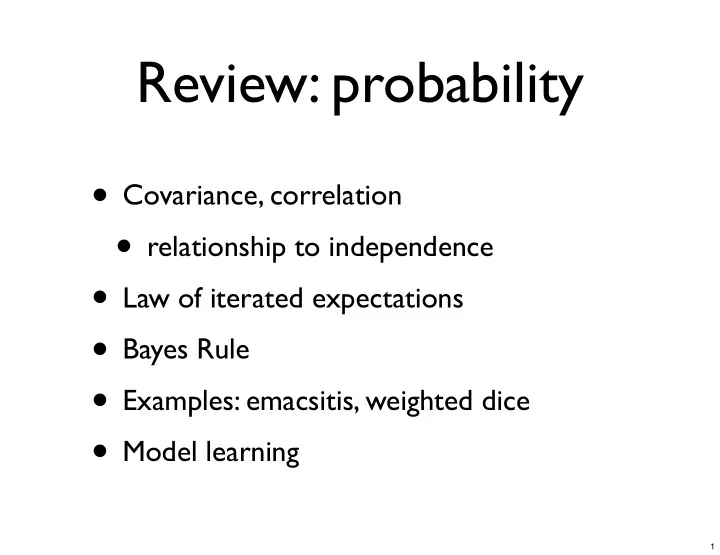

Review: probability • Covariance, correlation • relationship to independence • Law of iterated expectations • Bayes Rule • Examples: emacsitis, weighted dice • Model learning 1
Review: graphical models • Bayes net = DAG + CPT • Factored representation of distribution • fewer parameters • Inference: showed Metal & Outside independent for rusty-robot network 2
Independence • Showed M ⊥ O • Any other independences? • Didn’t use • independences depend only on • May also be “accidental” independences 3
Conditional independence • How about O, Ru? O Ru • Suppose we know we’re not wet • P(M, Ra, O, W, Ru) = P(M) P(Ra) P(O) P(W|Ra,O) P(Ru|M,W) • Condition on W=F, find marginal of O, Ru 4
Conditional independence • This is generally true • conditioning on evidence can make or break independences • many (conditional) independences can be derived from graph structure alone • “accidental” ones are considered less interesting 5
Graphical tests for independence • We derived (conditional) independence by looking for factorizations • It turns out there is a purely graphical test • this was one of the key contributions of Bayes nets • Before we get there, a few more examples 6
Blocking • Shaded = observed (by convention) 7
Explaining away • Intuitively: 8
Son of explaining away 9
d-separation • General graphical test: “d-separation” • d = dependence • X ⊥ Y | Z when there are no active paths between X and Y • Active paths (W outside conditioning set): 10
Longer paths • Node is active if: and inactive o/w • Path is active if intermediate nodes are 11
Another example 12
Markov blanket • Markov blanket of C = minimal set of observations to render C independent of rest of graph 13
Learning Bayes nets P(M) = P(Ra) = P(O) = M Ra O W Ru P(W | Ra, O) = T F T T F T T T T T P(Ru | M, W) = F T T F F T F F F T F F T F T 14
Laplace smoothing P(M) = P(Ra) = P(O) = M Ra O W Ru P(W | Ra, O) = T F T T F T T T T T P(Ru | M, W) = F T T F F T F F F T F F T F T 15
Advantages of Laplace • No division by zero • No extreme probabilities • No near-extreme probabilities unless lots of evidence 16
Limitations of counting and Laplace smoothing • Work only when all variables are observed in all examples • If there are hidden or latent variables, more complicated algorithm—we’ll cover a related method later in course • or just use a toolbox! 17
Factor graphs • Another common type of graphical model • Uses undirected, bipartite graph instead of DAG 18
Rusty robot: factor graph P(M) P(Ra) P(O) P(W|Ra,O) P(Ru|M,W) 19
Convention • Don’t need to show unary factors • Why? They don’t affect algorithms below. 20
Non-CPT factors • Just saw: easy to convert Bayes net → factor graph • In general, factors need not be CPTs: any nonnegative #s allowed • In general, P(A, B, …) = • Z = 21
Ex: image segmentation 22
Factor graph → Bayes net • Conversion possible, but more involved • Each representation can handle any distribution • Without adding nodes: • Adding nodes: 23
Independence • Just like Bayes nets, there are graphical tests for independence and conditional independence • Simpler, though: • Cover up all observed nodes • Look for a path 24
Independence example 25
Modeling independence • Take a Bayes net, list the (conditional) independences • Convert to a factor graph, list the (conditional) independences • Are they the same list? • What happened? 26
Inference • We gave an example of inference in a Bayes net, but not a general algorithm • Reason: general algorithm uses factor-graph representation • Steps: instantiate evidence, eliminate nuisance nodes, answer query 27
Inference • Typical Q: given Ra=F, Ru=T, what is P(W)? 28
Incorporate evidence Condition on Ra=F, Ru=T 29
Eliminate nuisance nodes • Remaining nodes: M, O, W • Query: P(W) • So, O&M are nuisance—marginalize away • Marginal = 30
Elimination order • Sum out the nuisance variables in turn • Can do it in any order, but some orders may be easier than others • Let’s do O, then M 31
One last elimination 32
Recommend
More recommend